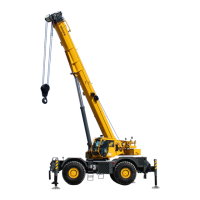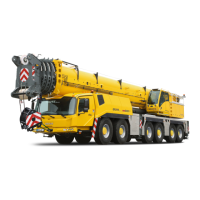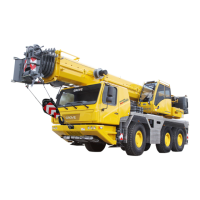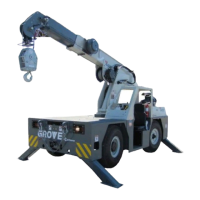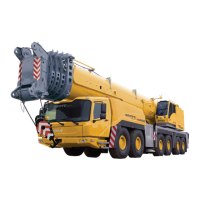Grove Published 01-29-2015, Control # 512-01 3-9
TMS700E SERVICE MANUAL ELECTRIC SYSTEM
e. If the engine starts, then shuts down, suspect a
faulty engine control system. Refer to the engine
manual for further instructions.
NOTE: If the starter won’t disengage during running, verify
the starter is mounted properly so its gear won’t
mesh with the engine’s flywheel when not trying to
start engine. Troubleshoot the starter relay and
ignition switch for closed contacts. If these
components check out, replace the starter.
Troubleshooting Engine Charging Problems
1. Verify battery terminals are connected and clean and all
wires in the charging system are in good repair and are
connected properly.
2. Verify the alternator belt is properly installed and is
under proper tension.
3. Verify the battery puts out 12 volts minimum. Charge
battery as needed so the battery can supply a minimum
excitation voltage to the engine’s charging system.
4. Verify there is a minimum of 12 volts at the alternator
from the battery, and that the alternator is properly
grounded.
5. Replace the alternator if the other conditions check out.
6. Refer to the engine manual for further instructions.
NOTE: If the alternator runs noisily, check belt tension. If
problem persists, replace alternator.
If the alternator overcharges (voltmeter reads high,
light bulbs burn out quickly), look for a ground
where one shouldn’t exist. If external wiring checks
out, replace alternator. (The alternator probably
has an internal ground or a faulty internal voltage
regulator.)
Troubleshooting Accessories
If the crane’s engine starts and charges properly, but none of
its components except the horn or lights work, the accessory
circuitry may be faulty. Check as follows:
1. Turn the ignition switch to the ACC (3) position. Try to
turn on the cab circulating fan, the heater fan, the
defroster fan, or the windshield wipers or washer. If none
of these come on (but the head lights, tail lights, marker
lights, dome light, work light, or gauge lights and panel
lights will come on), there is an accessory circuit
problem.
NOTE: Steps 2 thru 4 are referring to the carrier accessory
circuits. They also apply to the superstructure
except the relays are K1 and K2.
2. Check the primary power circuit to the accessory relays
K101 and K102. Make circuit repairs as needed.
3. If the problem remains, check the ignition switch and the
accessory control circuit from the ignition switch through
the coil of the accessory relays K101 and K102 to
ground. Turn the ignition switch to the ACC (3) position
and listen for audible click of relays K101 and K102. If
neither relay clicks, then there is no power through the
switch when it is in the ACC (3) position. Replace
ignition switch if there is no power through it when in the
ACC (3) position. If one relay clicks and the other does
not, check continuity of the coil of the relay that does not
click. If there is no continuity through its coil, replace the
relay. Make circuit repairs to accessory control circuit as
needed.
4. If the problem remains, check the accessory relay K101
or K102 contacts and the accessory power circuit.
Replace relay if its contacts stay open when the coil is
energized. Make circuit repairs as needed.
Troubleshooting Swivel-Caused Electrical
Problems
Many crane component electrical troubles can be traced to
the electrical swivel. Troubles common to the swivel are
improper mounting, foreign material between the brushes
and slip rings, incorrect wiring from the swivel to the
components, incorrect replacement wire size, worn brushes,
improper spring tension on the brush assembly, and loose
setscrews on the slip ring assembly. Refer to the electrical
schematic and wiring diagram for slip ring connections and
amperages.
Connector Troubleshooting
The cause of an electrical problem may be a loose or
corroded connection in the pin or socket connectors. Check
the connectors to ensure that the pins and sockets are
properly seated and engaged. If the pins and sockets show
any signs of corrosion, use a good quality electrical contact
cleaner or fine sandpaper to clean them. When the pins or
sockets show signs of arcing or burning, it will probably be
necessary to replace them.
Refer to Table 3-5 through 3-8 for listing of tools necessary
for connector maintenance.
Because the pins and sockets are crimped to the wires, it is
not possible to remove them. Using the proper extraction
tool, remove the pin(s) or socket(s) from the plug or
receptacle. Cut the wire as close to the pin or socket as
possible. After cutting the pin or socket off, the wire will most
likely be too short. Using a wire that is too short will allow
pressure to be applied to the pin or socket and wire where
they are crimped when the pin or socket is inserted in the
plug or receptacle. Add a short length of the same size wire
to the short wire by crimp splice or solder. Use heat
shrinkable tubing or other suitable material to insulate the
splice.
Reference Only
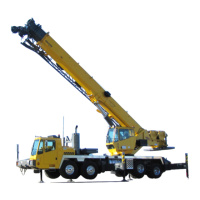
